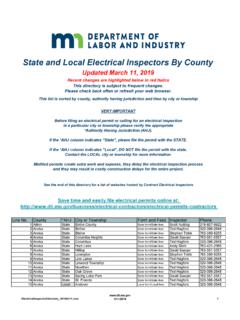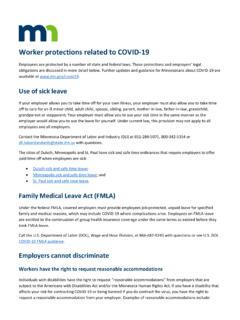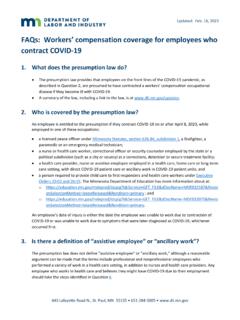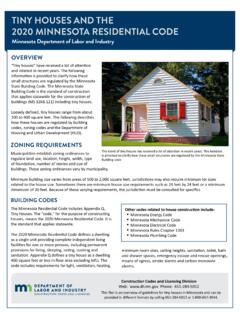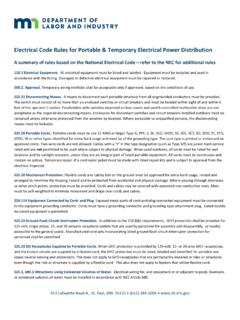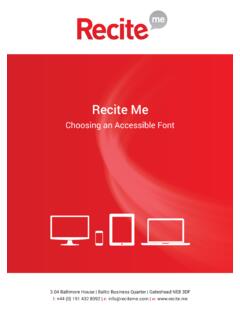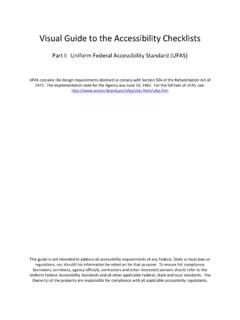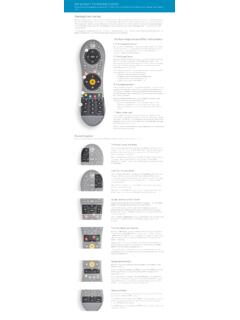Transcription of Guide to the Minnesota State Building Code
1 Minnesota . Guide to the State Building Code Administration accessibility Special Provisions Mechanical and Fuel Gas Commercial Building Plumbing Elevators and Related Devices High Pressure Piping Systems Residential Building Manufactured Homes Existing Buildings Prefabricated Structures Electrical Industrialized/Modular Buildings Flood-proofing Storm Shelters Energy Conservation G U I D E T O T H E S TAT E B U I L D I N G C O D E. INTRODUCTION. For nearly 50 years, the Minnesota State Building Code has been the standard by which buildings have been constructed to provide our citizens with safe, energy efficient and accessible buildings. From the many buildings built during those years, no one will know the countless lives saved from fire, structural collapse and hazardous materials; the injuries prevented from falls, shattered glass and electric shock; or the prevention of damage to buildings from roof ice, frost heave or water leakage. In addition, many hundreds of buildings are now fully accessible and usable for our family members and friends with disabilities while much less fossil fuel has had to be burned to heat and cool these same buildings.
2 This Guide looks back to the original intent of the legislature to provide safe and affordable housing, places to work, shop, eat, congregate, do business, recreate and worship. It reviews where these protections currently exist in the State and what codes are in place to ensure this occurs. The purpose of this Guide is to inform and educate regulators, government officials and policy makers about the State Building Code and how it serves the public's interest by providing for the safe use of buildings. Because one of the most important roles of government is to protect its citizens, it is our responsibility to ensure this occurs in the construction of buildings. Scott D. McLellan State Building Official TABLE OF CONTENTS. History 5. Legislative Intent 6. Purpose 7. Federal Impact 8. Uniformity 9. Benefits 10. Requirements 11. Enforcement Areas 12. Chapters 13. Code Book Fact Sheets Minnesota Building Code Administration 14. Minnesota Provisions to the State Building Code 15.
3 Minnesota Building Code 16. Minnesota Elevator and Related Devices Code 17. Minnesota Residential Code 18. Minnesota Conservation Code for Existing Buildings 19. Minnesota Energy Code 20. Minnesota accessibility Code 21. Minnesota Mechanical and Fuel Gas Code 22. Minnesota Plumbing Code 23. High Pressure Piping Code 24. National Electrical Code 25. Industrialized Modular Buildings 26. Minnesota Manufactured Home Code 27. Prefabricated Buildings 28. Flood-Proofing Regulations 29. Storm Shelters 30. HISTORY. 1965 A State Building Code was established that applied only to State -owned buildings. 1971 The first State Building Code was enacted into law that applied to all areas of Minnesota that enforced a Building code. Up to this point, each municipality maintained its own unique Building code or had none at all. 1972 The State Building Code became effective on July 1. If a municipality enforced a Building code, it now had to be the State Photo credit: Ben Franske - Own work, GFDL, Building Code.
4 1977 Legislation established that the State Building Code would be enforced statewide beginning Jan. 1, 1977, but no later than Jan. 1, 1978. Subsequent legislation passed in 1978 extended the date for mandatory State -wide enforcement of the State Building Code to Jan. 1, 1979. 1979 Legislation provided that a non-metropolitan county may by negative referendum rescind enforcement of the State Building Code (except provisions for accessibility ). This enabled county residents and those residing in cities that had not already adopted the code by January 1977 to participate in the vote. If the vote was negative, the code no longer applied to townships or cities located within the county. As a result of the referendums, only eight counties voted to retain the State Building Code. These were in addition to the seven mandatory metropolitan counties. 1981 Legislation allowed municipalities having a population of less than 2,500 to decide whether or not the State Building Code will apply in their jurisdiction.
5 If these municipalities had already adopted the code, they can now rescind their ordinance adopting the State Building Code (unless they were located in one of the seven metropolitan counties mandated to enforce the State Building Code). 2008 Legislation established for the first time that the State Building Code is the standard that applies statewide for the construction and remodeling of buildings. This means that the State Building Code now applies to all work, regardless of whether or not the State Building Code is required to be enforced by a municipality. This applies to everyone who constructs or remodels buildings, both homeowners and contractors. 2008 Legislation established that as of Jan. 1, 2008, if a municipality had in effect an ordinance adopting the State Building Code, that municipality must continue to enforce the State Building Code and may not repeal its adopting ordinance. The exception is for those municipalities having a population of less than 2,500 (as permitted by the 1981 legislation).
6 Guide to the State Building Code | 5. LEGISLATIVE INTENT. Below is an excerpt from the 1971 Session Laws when the legislature first authorized creation of a State Building Code. The purpose of the code, as shown in the first and fourth paragraphs, still appears today in Minnesota Statute The second and third paragraphs describe factors facing the construction industry and society at the time that likely contributed to the establishment of the first State Building Code. LAWS 1971 REGULAR SESSION. Be in enacted by the Legislature of the State of Minnesota : Section 1. Minnesota Statutes 1969, Section , is amended to read: State Building CODE; POLICY AND PURPOSE;. APPROPRIATING MONEY. Sections 1 to 17 of the act are enacted to enable the commissioner of administration to promulgate and administer a State Building code in accordance with the provisions hereof, which code shall govern the construction, reconstruction, alternation, and repair of State -owned buildings and other structures to which the code is applicable.
7 It is necessary that Building codes be adopted and enforced to protect the health, safety, welfare, comfort, and security of the residents of this State . However, the construction of buildings should be permitted at the least possible cost consistent with recognized standards of health and safety. Many citizens of the State are unable to secure adequate housing at prices or rentals which they can afford. Such a situation is contrary to the public interest and threatens the health, safety, welfare, comfort, and security of the people of the State . Other persons in commerce and industry are also affected by the high cost of construction. Construction costs for buildings of all types have risen and are continuing to rise at unprecedented rates. A multitude of laws, ordinances, rules, regulations, and codes regulating the construction of buildings and the use of materials therein is a factor contributing to the high cost of construction. Many such requirements are obsolete, complex, and unnecessary.
8 They serve to increase costs without providing correlative benefits of safety to owners, builders, tenants, and users of buildings. It is the purpose of this act to prescribe and provide for the administration and amendment of a State code of Building construction which will provide basic and uniform performance standards, establish reasonable safeguards for health, safety, welfare, comfort, and security of the residents of this State who are occupants and users of buildings, and provide for the use of modern methods, devices, materials, and techniques which will in part tend to lower construction costs. 6 | Guide to the State Building Code PURPOSE. The purpose of the State Building Code is described in Minnesota Statutes where it reads: . The commissioner shall administer and amend a State code of Building construction which will provide basic and uniform performance standards, establish reasonable safeguards for health, safety, welfare, comfort, and security of the residents of this State and provide for the use of modern methods, devices, materials, and techniques which will in part tend to lower construction costs.
9 The construction of buildings should be permitted at the least possible cost consistent with recognized standards of health and safety. In other words: Basic minimum Uniform everyone designs and builds to comply with the same requirements Performance standards requirements should focus on the outcome not specific methods Reasonable safeguards not overly complex, costly or difficult Health safe clean water, proper sewer, sanitation, air quality, light, ventilation Safety protection from fire, smoke, falling, wind, snow, frost, extreme temperature, electrocution, hazardous materials, panic, breaking glass, structural collapse Welfare accessibility , conserves energy resources, peace of mind, habitability Comfort heating facilities, soundproofing between apartments, room size Security school safety, nursing home dementia units, correctional facilities Provide for the use of modern methods, devices, materials and techniques which will in part tend to lower construction costs encourage and recognize innovation and technologies that provide cost savings in labor, equipment.
10 And Building materials The construction of buildings should be permitted at the least possible cost consistent with recognized standards of health and safety manage adoption of nationally recognized safety and health codes to keep construction costs as low as possible Guide to the State Building Code | 7. FEDERAL IMPACT. Energy Minnesota is obligated to review and adopt a new commercial energy code when recommended by the Department of Energy. However, when a new, more efficient residential energy code becomes available, Minnesota is only required to review and consider adopting the new code. Manufactured Homes Since 1976, Minnesota has been a State Administrative Agency (SAA) for the Department of Housing and Urban Development for the installation of manufactured homes. As a condition of being an SAA, Minnesota must adopt installation and dispute-resolution programs compatible with federal regulations for manufactured homes. Prefabricated Structures Since 1995, Minnesota has been part of an interstate compact for the regulation of prefabricated structures and modular buildings.



